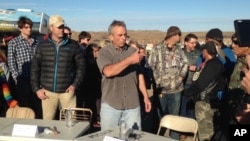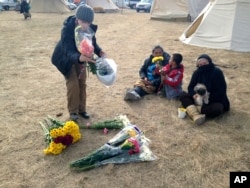A federal judge most likely won't decide until early next year whether to give the developer of the Dakota Access oil pipeline permission to finish the $3.8 billion project, according to court documents.
That leaves open the possibility that a resolution to the matter might still come through federal regulators rather than the courts. But it also creates the potential for many more weeks of protests in southern North Dakota, where opponents have started digging in for the winter, and millions more spent on law enforcement-related costs.
Dallas-based Energy Transfer Partners asked U.S. District Judge James Boasberg on Tuesday to declare it has the legal right to lay pipe under a Missouri River reservoir in southern North Dakota, the remaining unbuilt chunk of the 1,200-mile pipeline to move North Dakota oil to a shipping point in Illinois.
More input from tribe
The company's move was spurred by the U.S. Army Corps of Engineers' call Monday for more study and input from the Standing Rock Sioux before deciding whether to approve an easement for the pipeline to cross under Lake Oahe, the reservoir from which the tribe draws drinking water. The tribe believes the pipeline threatens water and cultural sites.
Company lawyers have proposed a schedule under which a hearing would be held "on or about" January 3, and Boasberg would make a decision sometime after that.
When the tribe asked Boasberg in August to temporarily stop pipeline construction, he ruled 12 business days after a hearing. If he follows a similar timeline, a decision on ETP's request would come January 19 — one day before Donald Trump, who has said he wants to rebuild energy infrastructure and owns stock in ETP, assumes the White House.
Attorney Jan Hasselman with environmental group Earthjustice, which is representing the tribe in its lawsuit, doesn't think the Obama administration will leave the matter to Trump.
"No. They know how that story ends," he said.
It's unclear, though, what kind of a timeline the corps will follow for further consultation with the tribe and a decision on an easement.
Army Assistant Secretary Jo-Ellen Darcy said Monday that that it would be done "expeditiously." Corps spokeswoman Moira Kelley said Wednesday that the agency was awaiting a response from the tribe, and "we will have more information on the timeline once the discussion begins."
"It would seem that it is in the best interest of all the parties involved to move quickly," she said.
Standing Rock tribal Chairman Dave Archambault didn't immediately comment Wednesday.
'Prolong the disruption'
The delay frustrates North Dakota leaders. Republican U.S. Senator John Hoeven this week said it "will only prolong the disruption in the region."
Since August, protests at pipeline work sites, near encampments and in the Bismarck-Mandan area have resulted in nearly 500 arrests. The state has approved up to $10 million in emergency spending to cover law enforcement-related costs.
Governor Jack Dalrymple said Tuesday that further delays "simply prolong the risks to public safety, prolong the hardships endured by area residents and increase costs."
Meanwhile, winter is imminent for the hundreds of people living in the protest camp. On Tuesday, people erected large tents and circular domed dwellings known as yurts, complete with stoves. A snowstorm is likely to miss the area Thursday.








